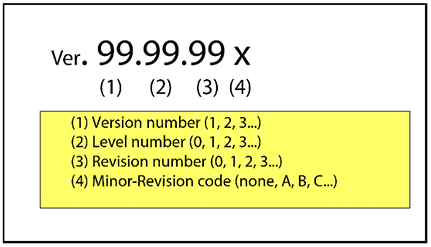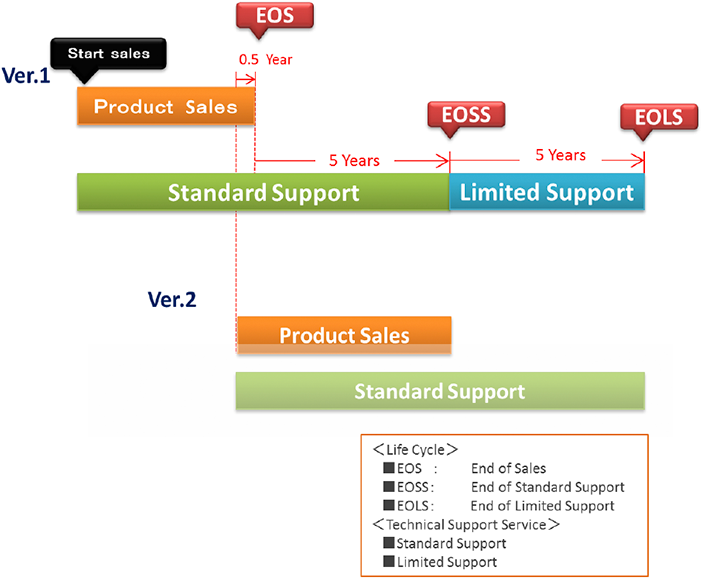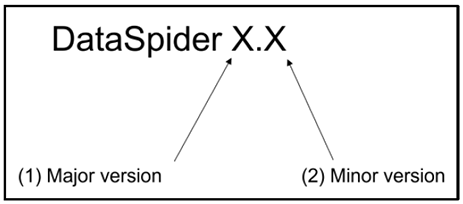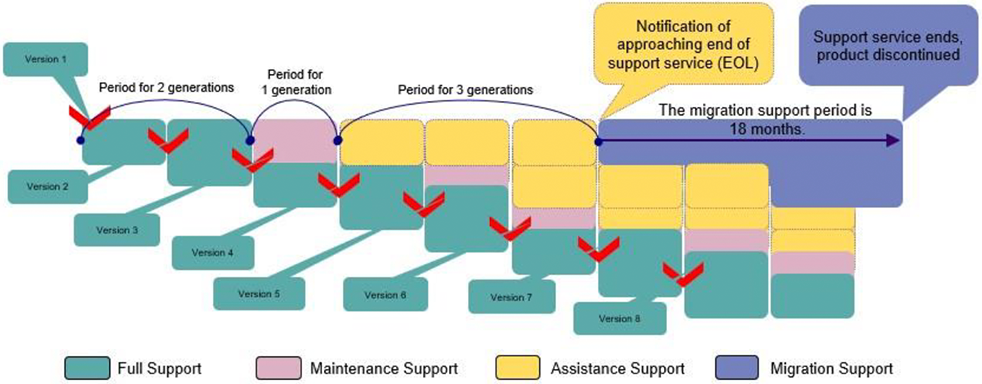Life Cycle
HULFT Series Life Cycle
Product Version Definition

The version of our company products is managed through:
"Version number"
"Level number"
"Revision number"
"Minor-Revision code"
(1) Version upgrade (Vup)
- Version upgrade is the update for the change in product concept or to substantially expand the product function.
- Large-scale functional improvement and addition will be implemented.
- This may accompany specification changes and changes in product configuration and prices.
(2) Level upgrade (Lup)
- Level upgrade is the update to expand the product functions.
- Mainly the functional improvement and addition will be implemented
- As a result, this may be accompanied by specification changes and changes in product configuration.
(3) Revision upgrade (Rup)
- Revision upgrade is the update to fix bugs.
- It may be implemented through small-scale improvements that will not accompany specification changes.
(4) Minor-Revision Upgrade (Mrup)
- Minor-Revision Upgrade mainly fixes urgent and critical failures.
- The following are considered as urgent and critical failures.
- Failures with a wide range of impact (many users will be affected)
- Failures with no workaround
- The upgrade may be implemented without modifying modules in order to identify the existing version due to product configuration.
- Functional improvement and addition
Refers to the expansion of current functions or adding new functions.
Due to the functional improvement and addition, specification change *2 may take place. - Specification change
Refers to changes in content (function, operation, setup items, etc.) that are described in our product manuals.
It may affect user interface or operability.
In principle, updates that require specification changes are limited to version upgrades and level upgrades that implement functional improvement and addition.
However, in critical circumstances where the failure needs to be fixed immediately, we may use the revision upgrade or minor-revision upgrade to implement specification changes (due to defect in specification itself). For those cases, we will give you advance notice. - Failure
Refers to a case when the product does not operate in accordance with our product manual. - Improvement
Refers to improvements that do not accompany any specification changes and do not affect customers' operation (without below *5 incompatibility).
Modification for the expansion of OS is also included. - Non compatible
Refers to changes in products operability due to specification change.
In case incompatibility occurs, we will inform you in advance with the explanation for each product.
- Functional improvement and addition
Product Life Cycle
1. Product sales life cycle
- We sell only the latest version products in principle.
- However, after the release of the latest version product, we will continue to sell the version that is one generation older for at least 6 months.
2. Technical support service life cycle
- After the termination of the product sales, we will provide technical support services in the form of Standard Support (regular support) for five years and Limited Support (extended support) for another five years.
- We will inform you in advance when the period approaches the termination of sales of older version product, termination of the technical support services, and the termination of extended technical support services.
- In principle, the notification of the termination of product sales will be given at least six months in advance. For the termination of technical support services, notification will be given at least one year ahead.

The new lifecycle policy will be applied from the next major version upgrade of each HULFT product. Please click here for details.
DataSpider Life Cycle
Product Version Definition
The meaning of DataSpider version numbers is shown below.

(1) Major version
The major version is indicated by the first number from the left.
Example: DataSpider Servista 3.0
The major version number increments when modifications are made to the underlying architecture in the current version of the product, or when major new functions and tools are added.
(2) Minor version
The minor version is indicated by the second number from the left.
Example: DataSpider Servista 3.2
The minor version number increments when new features and bug fixes are provided within the scope of a major version that has already been released.
A newly released minor version includes all of the service packs and patches that were provided during the time from the previous minor version until the release of the new minor version. (However, this does not include patches that are provided separately.)

Support Life Cycle
- The support life cycle described below has been applied since February 1, 2008.
- The DataSpider support level changes each time a minor version product is released. The timing of this change varies by each level.
- (1)
Full Support
When a new version is released, the support level is Full Support.
2 generations, counting back from the newest version and including minor versions, are covered by Full Support.
- (2)
Maintenance Support
The version that becomes the 3rd generation, counting back from the newest version, is automatically migrated to Maintenance Support.
- (3)
Assistance Support
The versions that become the 4th through 6th generations, counting back from the newest version, are covered by Assistance Support.
- (4)
Migration Support
When a version becomes the 7th generation, counting back from the newest version, it is transferred to Migration Support.
At the time of this migration, a Notification of Approaching End of Support Service (Notification of EOL) is issued for the relevant version.
The migration support period is 18 months. When this period has passed, the status will change to End of Support for Inquiries (End of Life).

The next time DataSpider undergoes a major version upgrade, the new policy will be applied. Please click here for details.
